


Violent decomposition of perchlorate with organic cation
This is a simple but spectacular experiment in which a perchlorate salt is made from an organic cation and in which there is a perfect oxygen/fuel balance. The salt is stable at room temperature, but when it is heated it sets off with a beautiful voluminous pink flame.

The compound made in this experiment should not be confused with a truly organic perchlorate, in which the perchlorate is in ester-form. Such perchlorate esters are much more dangerous to handle than the perchlorate salt made in this experiment. This experiment can be carried out safely as long as it is not scaled up.
![]()
![]() Required
chemicals:
Required
chemicals:
-
perchloric acid, 10% solution in water
-
ethylene diamine, 10% solution in water
-
sodium bicarbonate
![]() Required
equipment:
Required
equipment:
- small 25 ml beaker
- glass rod
- petri dish or hour glass
![]() Safety:
Safety:
- Perchloric acid at a concentration of 10% is moderately corrosive. Acid of much higher concentration, however, is highly corrosive and acid with a concentration of well above 70% can even cause explosions when it comes in contact with organic matter.
- Pure ethylene diamine is irritating and corrosive and fumes in contact with air, but the 10% solution in water can be handled without any problem.
![]() Disposal:
Disposal:
- Waste from this experiment can be flushed down the drain.
![]()
Preparation of solid ethylene diamine perchlorate
![]() Take 5 ml of 10% perchloric acid and put this in a small
beaker.
Take 5 ml of 10% perchloric acid and put this in a small
beaker.
![]() Take 1
ml of 10% ethylene diamine and add this to the dilute perchloric acid. Stir with
a glass rod to mix the chemicals.
Take 1
ml of 10% ethylene diamine and add this to the dilute perchloric acid. Stir with
a glass rod to mix the chemicals.
![]() Add more
ethylene diamine drop-wise and after each few drops stir the liquid and then
take the glass rod out of the liquid and touch a glass surface, such that a drop
of liquid gets on the glass. Add a tiny amount of solid sodium bicarbonate to
such a drop. If it fizzles, then there still is excess acid in the liquid and
more drops of 10% ethylene diamine should be added. Keep on adding liquid until
a drop from this liquid does not fizzle anymore when in contact with sodium
bicarbonate. Be sure that the liquid is not contaminated with sodium ions.
Add more
ethylene diamine drop-wise and after each few drops stir the liquid and then
take the glass rod out of the liquid and touch a glass surface, such that a drop
of liquid gets on the glass. Add a tiny amount of solid sodium bicarbonate to
such a drop. If it fizzles, then there still is excess acid in the liquid and
more drops of 10% ethylene diamine should be added. Keep on adding liquid until
a drop from this liquid does not fizzle anymore when in contact with sodium
bicarbonate. Be sure that the liquid is not contaminated with sodium ions.
![]() The
resulting liquid (which has a slight excess of ethylene diamine) is transferred
to a hour glass or petri dish and the glass or dish is put in a warm dry place
(e.g. on a central heating radiator). Let the liquid evaporate for a few days.
Evaporation is very slow and the final result is a somewhat sticky crystalline
mass. No nice dry solid is obtained under these drying conditions (the material
is very hygroscopic).
The
resulting liquid (which has a slight excess of ethylene diamine) is transferred
to a hour glass or petri dish and the glass or dish is put in a warm dry place
(e.g. on a central heating radiator). Let the liquid evaporate for a few days.
Evaporation is very slow and the final result is a somewhat sticky crystalline
mass. No nice dry solid is obtained under these drying conditions (the material
is very hygroscopic).
![]() The
solid is scraped on a little pile with a plastic spatula. Do not use a metal
spatula, that would contaminate the material. The resulting material is a pale
yellow and somewhat transparent sticky mass.
The
solid is scraped on a little pile with a plastic spatula. Do not use a metal
spatula, that would contaminate the material. The resulting material is a pale
yellow and somewhat transparent sticky mass.

The material still looks quite wet, but better drying results could not be obtained on the heating radiator. Each time when this cools down, the material attracts moisture from the air again. In order to make it really dry, the material must be kept at a warm and dry place for 24 hours or more without cooling down in the meantime. This was tested by keeping the hour glass with the material on a central heating unit for more than 24 hours. The top surface of the central heating unit does not go below 40 �C in wintertime. Immediately after the material was taken from the central heating unit surface it was scraped off the hour glass and transferred to an air-tight vial to keep it dry. When it is kept in contact with colder air, then it quickly becomes sticky again.
![]()
Igniting the solid material above a flame
The solid material can be put on a small metal spatula (not more than a pile of 3 mm diameter and height should be used). It simply sticks to the spatula. Put the spatula with the solid material just above the flame of a small alcohol burner. The solid then quickly melts and then starts sputtering and tiny droplets are sprayed around. These droplets cause small flashes of fire. When heating is continued, then suddenly the whole molten mass inflames, giving a big fireball (which is really big for such a small amount of liquid) having a pink color. No smoke is produced in the reaction, but after the reaction a pungent/irritating smell can be observed, so it is best to do this experiment in a well ventilated room. After the reaction no material is left behind on the spatula. Below, a series of pictures is given, which demonstrates the inflaming of the material and the phenomena just before and just after the appearance of the fire ball.
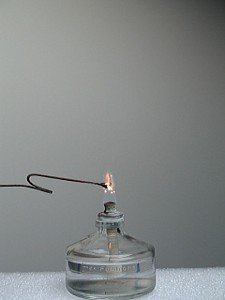
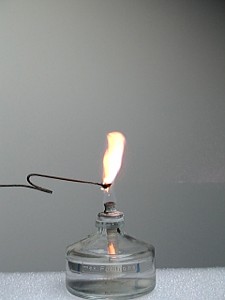
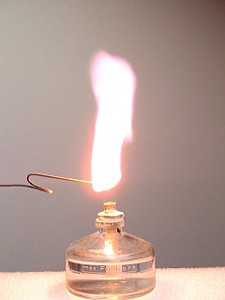
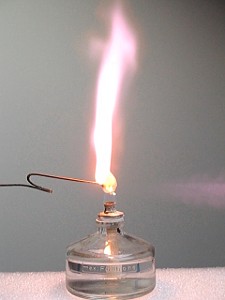
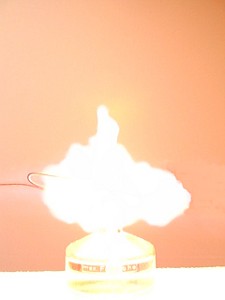
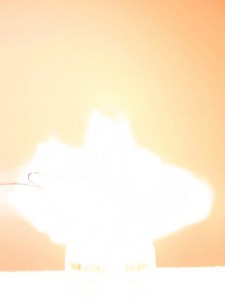
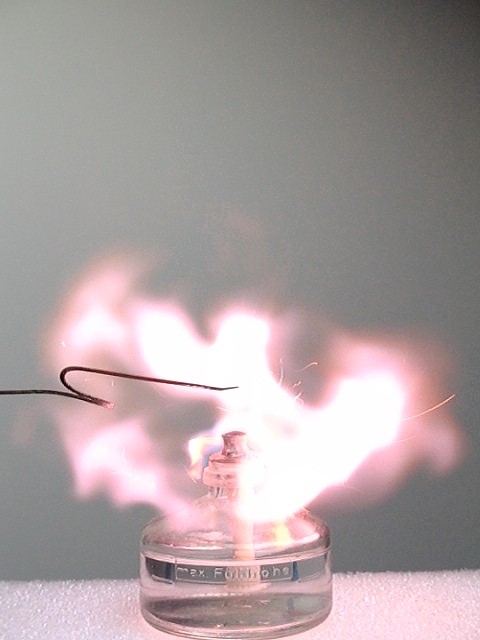
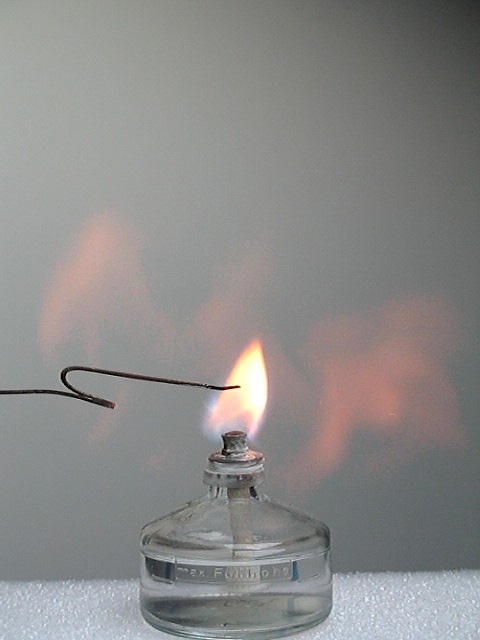
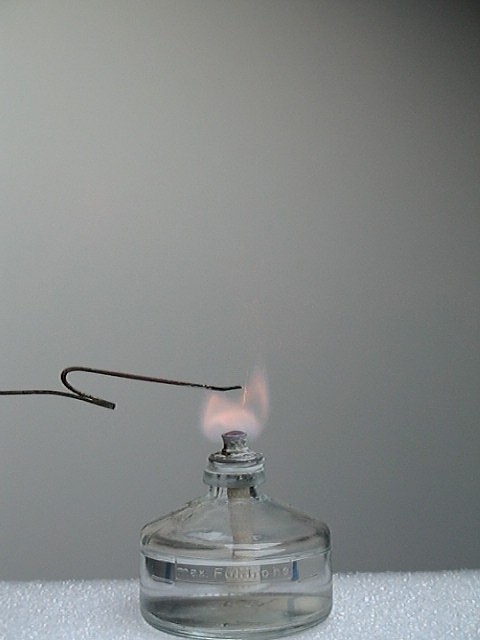
The pictures show that the fire ball is very bright and also that it is huge, compared to the tiny amount of material which is used for producing the fire ball.
Both the somewhat sticky/wet material and the perfectly dry material give the same results. The dry material also melts and sputters somewhat before a fire ball is obtained. Apparently any water in the humid material first boils off.
A video of the reaction can be downloaded here. Download size is approximately 5 MByte.
![]()
Discussion of results
![]() Ethylene
diamine contains two amine groups, which both can accept a proton. This is like
ammonia, which can accept a proton to form the ammonium ion. The main difference
is that here there are two nitrogen atoms which can accept a proton:
Ethylene
diamine contains two amine groups, which both can accept a proton. This is like
ammonia, which can accept a proton to form the ammonium ion. The main difference
is that here there are two nitrogen atoms which can accept a proton:
H2NCH2CH2NH2 + 2H+ → +H3NCH2CH2NH3+
This ion easily forms salts with suitable anions. Commercial salts of this ion are available, such as the chloride and the sulfate.
![]() With
perchloric acid, the corresponding salt H3NCH2CH2NH3(ClO4)2 is
formed. This salt is hygroscopic but it can be isolated as a somewhat sticky
solid mass.
With
perchloric acid, the corresponding salt H3NCH2CH2NH3(ClO4)2 is
formed. This salt is hygroscopic but it can be isolated as a somewhat sticky
solid mass.
![]() The
solid salt contains both the fuel and the oxidizer for the combustion. There is
a perfect oxygen balance for the internal redox reaction. The oxygen and
chlorine of the perchlorate ion bind to carbon and hydrogen and in this process
a lot of energy is released. All reaction products are gaseous and that
explains the huge fire ball.
The
solid salt contains both the fuel and the oxidizer for the combustion. There is
a perfect oxygen balance for the internal redox reaction. The oxygen and
chlorine of the perchlorate ion bind to carbon and hydrogen and in this process
a lot of energy is released. All reaction products are gaseous and that
explains the huge fire ball.
H3NCH2CH2NH3(ClO4)2 → 2CO2 + 2HCl + 4H2O + N2
The reaction products are gaseous and colorless, hence no visible smoke can be perceived.